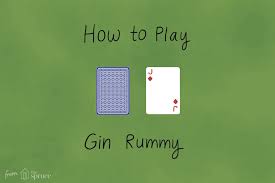Gin Rummy Rules is a popular two-player card game that combines elements of strategy, skill, and luck. Whether you’re a novice or an experienced player, understanding the rules of Gin Rummy is essential for mastering the game. This comprehensive guide will walk you through the basics, scoring, and strategies to help you play effectively.
Objective of the Game
The primary goal of Gin Rummy is to form sets and runs with the cards in your hand and reduce the value of any unmatched cards (deadwood). The game ends when one player reaches a predetermined score, typically 100 or 250 points.
The Deck
Gin Rummy is played with a standard 52-card deck. The cards rank from Ace (low) to King (high), with Aces worth 1 point, face cards (Kings, Queens, Jacks) worth 10 points each, and numbered cards worth their face value.
Dealing
- Players: Gin Rummy is designed for two players.
- Deal: Each player is dealt 10 cards. The dealer alternates each round. The remaining cards are placed face down to form the stockpile. The top card is turned face up next to the stockpile to start the discard pile.
Gameplay
1. Drawing a Card: At the start of each turn, a player can either:
- Draw the top card from the stockpile.
- Take the top card from the discard pile.
2. Forming Melds: Players aim to create melds in their hand, which can be:
- Sets: Three or four cards of the same rank (e.g., 7♠ 7♣ 7♦).
- Runs: Three or more consecutive cards of the same suit (e.g., 4♠ 5♠ 6♠).
3. Discarding a Card: After drawing and optionally forming melds, the player ends their turn by discarding one card to the discard pile.
4. Knocking and Going Gin:
- Knocking: A player can knock if the total value of their unmatched cards (deadwood) is 10 points or less. The player then places the knocked card face down and reveals their hand.
- Going Gin: If a player forms all their cards into melds with no unmatched cards, they can go gin, revealing their hand and earning a bonus.
Scoring
- Knock Points: If a player knocks, the opponent reveals their hand and lays off (adds) any unmatched cards that can form melds with the knocker’s cards. The difference between the knocker’s deadwood points and the opponent’s deadwood points is the score for that round.
- Gin Bonus: If a player goes gin, they earn a 25-point bonus, and the opponent cannot lay off any cards.
- Undercut Bonus: If the opponent’s deadwood points are equal to or less than the knocker’s, the opponent earns an undercut bonus of 25 points plus the difference in deadwood points.
Ending the Game
The game continues until one player reaches the agreed-upon score, usually 100 or 250 points. The player with the highest score at the end of the game is declared the winner.
Strategies for Success
1. Observing Opponent’s Discards: Keep track of the cards your opponent picks up and discards. This will give you clues about the sets and runs they are trying to form.
2. Prioritizing Runs: Runs are generally more flexible than sets. Focus on forming runs as they are less likely to be blocked by your opponent’s plays.
3. Early Discards: Discard high-value cards (10, J, Q, K) early if they don’t fit into your melds. This helps to minimize your deadwood points and reduces the risk if your opponent knocks early.
4. Holding Off on Knocking: Wait to knock until you have a strong hand or believe your opponent is close to going gin. This maximizes your chances of winning the round with a lower deadwood count.
5. Going for Gin: If you have a good hand, try to go gin. The gin bonus can significantly impact the overall score, giving you a substantial lead.
Common Variations
1. Oklahoma Gin: In this variation, the initial face-up card determines the maximum deadwood points allowed for knocking. If the card is a spade, the round’s score is doubled.
2. Hollywood Gin: Players keep track of three concurrent games, with scores added cumulatively across all games. This variation adds an extra layer of strategy and complexity.
3. Straight Gin: Players are not allowed to knock; they can only go gin. This makes the game more challenging and extends the duration of each round.
Conclusion
Gin Rummy is a game of skill, strategy, and a bit of luck. By understanding the rules and employing effective strategies, you can enhance your gameplay and increase your chances of winning. Whether you’re playing casually with friends or competing in online tournaments, mastering Gin Rummy will provide hours of entertainment and mental stimulation. So grab a deck of cards, find a partner, and enjoy the classic game of Gin Rummy!




